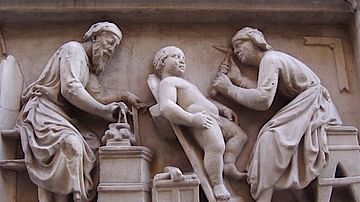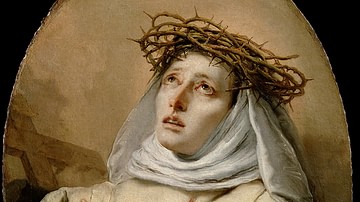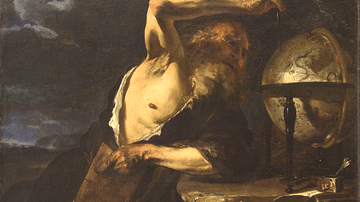Search
Search Results

Definition
Paolo Uccello
Paolo Uccello (1397-1475 CE), real name Paolo di Dono, was an Italian painter who is considered one of the founding fathers of Florentine Renaissance art. Uccello was one of the earliest artists to attempt certain tricks of perspective in...

Article
Life in a Renaissance Artist's Workshop
The majority of great Renaissance works of art were produced in large and busy workshops run by a successful master artist and his team of assistants and apprentices. Here, too, more mundane art was produced in larger quantities to meet the...

Definition
Sappho of Lesbos
Sappho of Lesbos (l. c. 620-570 BCE) was a lyric poet whose work was so popular in ancient Greece that she was honored in statuary, coinage, and pottery centuries after her death. Little remains of her work, and these fragments suggest she...

Definition
Cicero
Marcus Tullius Cicero was a Roman orator, statesman, and writer. He was born on 3 January 106 BCE at either Arpinum or Sora, 70 miles south-east of Rome, in the Volscian mountains. His father was an affluent eques, and the family was distantly...

Definition
Adelantado
Adelantado was an office awarded by the Spanish Crown to conduct military campaigns in the medieval period but then repurposed during the Age of Exploration to grant an individual the right to privately fund expeditions of discovery and conquest...

Image
Five Classical Orders of Serlio
A diagram showing the five classical orders as classified by the Italian Renaissance architect Sebastiano Serlio (c. 1475-1554 CE). Left to right: Tuscan, Doric, Ionic, Corinthian and Composite. From Book IV of Serlio's 'Complete Works on...

Image
Democritus by Dossi
Democritus, painting by Dosso and Battista Dossi, 1540.
Pinacoteca Civica Domenico Inzaghi, Budrio.

Image
St. Catherine of Siena
St. Catherine of Siena (1347-1380), oil on canvas portrait by Giovanni Battista Tiepolo, depicting St. Catherine of Siena wearing a crown of thorns, c. 1746.
The Kunsthistorisches Museum, Vienna, Austria

Image
Anaxagoras by Langetti
A 17th-century portrait by Giovanni Battista Langetti of Anaxagoras (l. c. 500-c. 428 BCE), the Pre-Socratic Greek philosopher who claimed the First Cause of existence was Mind (nous). (Philadelphia Museum of Art, USA)

Image
Queen Zenobia before Emperor Aurelianus
Queen Zenobia before Emperor Aurelianus. Giovanni Battista Tiepolo (1696–1770). Oil on canvas. Prado Museum.